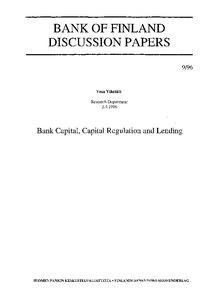Bank capital, capital regulation and lending
Vihriälä, Vesa (31.03.1996)
Numero
9/1996Julkaisija
Suomen Pankki
1996
Julkaisun pysyvä osoite on
https://urn.fi/URN:NBN:fi:bof-20140807140Tiivistelmä
The paper analyzes bank loan supply in a simple value maximizing partial equilibrium framework.The focus is on the role of bank capital, capital regulation and the pricing of bank liabilities.The model is constructed so as to resemble the situation of the Finnish local banks in the late 1980s and the early 1990s, particularly with regard to capital regulation which changed subtantially during this period.While equity capital is assumed exogenous, the bank may choose the amount of subordinated debt which also counts as regulatory capital.The model shows that bank characteristics matter for loan supply, when the bank is penalized for bank failure (capital insufficiency relative to a regulatory requirement).When this penalty is positive, fair or excessive pricing (lemons premium) of bank liabilities makes bank lending depend positively on bank capital but underpricing results in a negative relationship.A negative relationship may also emerge if the bank anticipates "perverse" bank support policies ie. that capital insufficiency will be rewarded with transfers from the authorities.Thus both a credit crunch due to lack of capital and "excessive" risky lending due to moral hazard can obtain in a single model, depending on the circumstances.The precise nature of capital regulation is not important, provided a failure to meet the requirement is sufficiently penalized.The model suggests that the mutually exclusive hypotheses of credit crunch excessive lending due to moral hazard can be tested not only by examining the relationship between bank lending on the one hand and bank equity and bank costs on the other hand, but also by examining the relationship of subordinated debt with bank lending and the capital ratio. Keywords: bank lending, capital, capital regulation, moral hazard, credit crunch
